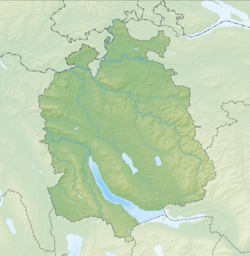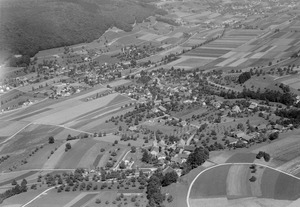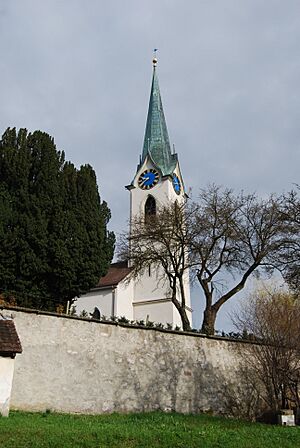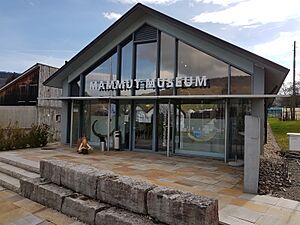Niederweningen facts for kids
Quick facts for kids
Niederweningen
|
||
|---|---|---|
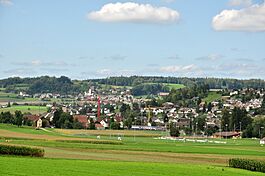 |
||
|
||
| Country | Switzerland | |
| Canton | Zurich | |
| District | Dielsdorf | |
| Area | ||
| • Total | 6.84 km2 (2.64 sq mi) | |
| Elevation | 505 m (1,657 ft) | |
| Population
(Dec 2020 )
|
||
| • Total | 3,089 | |
| • Density | 451.6/km2 (1,169.7/sq mi) | |
| Postal code |
8166
|
|
| Surrounded by | Otelfingen, Schleinikon, Schneisingen (AG), Siglistorf (AG), Unterehrendingen (AG), Wettingen (AG) | |
Niederweningen is a small town, also called a municipality, in Switzerland. It is located in the Dielsdorf district, which is part of the Zürich area. This town is especially famous for the discovery of ancient mammoths!
Contents
History of Niederweningen
Early Mentions and Railway
Niederweningen was first written about a very long time ago. This happened between the years 1096 and 1111. Back then, it was known as Waningen. Later, in 1269, its name was recorded as Nidirunweningin.
The railway came to Niederweningen in 1891. This was when the Swiss Northeastern Railway opened its Wehntal line. The train line was made a bit longer in 1938, reaching its current end point.
Ice Age Animal Discoveries
In 1890, something very exciting was found in Niederweningen. It was the most important site in Switzerland for Ice Age animals! People found many ancient animal remains here.
Scientists studied the ground deeply, finding a special layer of "Mammut" turf. More discoveries happened between 1983 and 1985. Then, in 2003, the bones of a Mammoth were found.
These amazing finds led to the creation of the Mammutmuseum Niederweningen. This museum is located close to where the first discoveries were made.
Famous People from Niederweningen
The well-known psychiatrist Adolf Meyer was born in Niederweningen in 1866. He became a very important figure in the field of mental health.
Geography of Niederweningen
Niederweningen covers an area of about 6.9 square kilometers (2.7 square miles). A large part of this land, about 48.2%, is used for farming. Forests cover another 38.3% of the area.
About 13.1% of the land has buildings or roads on it. A very small part, 0.4%, is made up of non-productive areas like rivers.
The town stretches along the Surb river. It runs through a valley called the Wehntal. The town goes from the northern edge of the Lägern ridge to new homes on the southern side of the Egg hill.
Population and Community
Population Details
Niederweningen has a population of 3,089 people (as of 31 December 2020). About 11.1% of the people living here are from other countries (as of 2007).
Over the last ten years, the number of people living in Niederweningen has grown quite a lot, by 37.8%. Most people in the town speak German (90.8%). Italian is the second most common language (1.7%), followed by Serbo-Croatian (1.4%).
Political Parties
In the 2007 election, the most popular political group was the SVP. They received 39.1% of the votes. Other popular parties included the SPS (13.8%), the Green Party (13.7%), and the FDP (10.2%).
Age and Education
Looking at the age of the population (as of 2000), children and teenagers (0–19 years old) make up 27% of the people. Adults (20–64 years old) are the largest group, at 64.9%. Seniors (over 64 years old) make up 8.1% of the population.
In Niederweningen, about 83.3% of adults aged 25–64 have finished higher education. This means they have completed either upper secondary education or a university degree.
Work and Economy
The unemployment rate in Niederweningen is 2.01%. As of 2005, there were 54 people working in the primary economic sector, which includes farming. There were 22 businesses in this area.
The secondary sector, which includes manufacturing, employed 453 people. This sector had 13 businesses. The tertiary sector, which includes services, employed 233 people and had 66 businesses.
Historical Population Growth
Here is a table showing how the population of Niederweningen has changed over many years:
| year | population |
|---|---|
| 1634 | 309 |
| 1850 | 806 |
| 1900 | 551 |
| 1950 | 841 |
| 2000 | 2,220 |
Sights in Niederweningen
The most famous sight in Niederweningen is the Mammoth Museum (Mammutmuseum). In 1890, workers building the railroad found bones of mammoths. These bones were first kept in a museum in Zurich.
Then, in 2003, an amazing discovery was made. A complete mammoth skeleton, about 34,000 years old, was found close to the 1890 site! Because of these finds, a museum was opened in Niederweningen in 2005.
The museum has one complete mammoth skeleton on display. Parts of at least nine different mammoth skeletons were found in the area. The museum also shows other animals from the Ice Age and items from early human settlements.
Transport in Niederweningen
Niederweningen has two railway stations. The Niederweningen railway station is the last stop on the Zürich S-Bahn line S15. A train ride from Zürich Hauptbahnhof (Zurich Main Station) takes about 35 minutes.
The other station is Niederweningen Dorf railway station. This station is one stop closer to Zurich on the same train line. Both stations are served by the same trains, making it easy to travel to and from Niederweningen.
See also
 In Spanish: Niederweningen para niños
In Spanish: Niederweningen para niños




